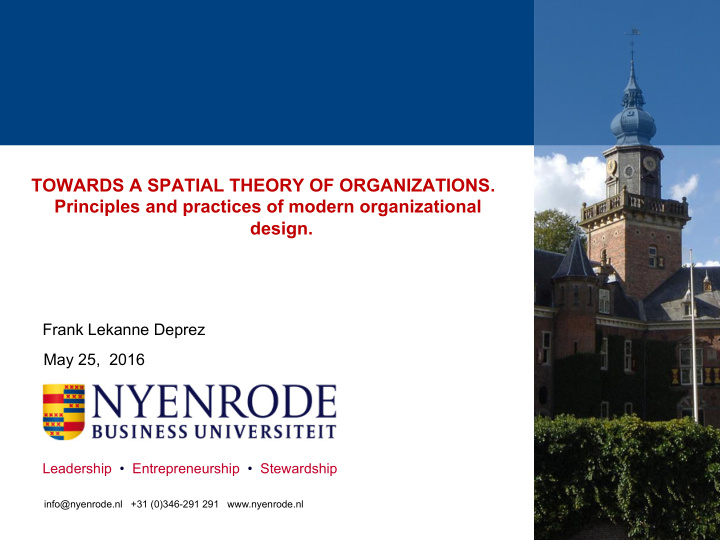



TOWARDS A SPATIAL THEORY OF ORGANIZATIONS. Principles and practices of modern organizational design. Frank Lekanne Deprez May 25, 2016 Leadership • Entrepreneurship • Stewardship info@nyenrode.nl +31 (0)346-291 291 www.nyenrode.nl
2 1. Why space? q We have organized everything except space. It’s the last fordable ‘place’ in the world of management and organizations, and it offers a world of opportunity. q Space has largely been a neglected–and even ignored phenomenon–within organization theory and management practice.
3 2. Making sense of space q Space only really makes sense in the presence of boundaries (Hernes, 2004). q Organizations take up a lot of space and their boundaries often are under constant change.
4 3. Making sense of space part 2 q It’s all about the mechanisms that govern what goes inside space. q In the organizational landscape there are three kinds of space that need to be ‘organized’ into productive spaces: q outer (‘physical’ space: place and time) q connective (‘virtual’ space: digital) q inner (‘mental’ space: mental, cognitive)
5 4.Why a spatial theory of organizations? A spatial theory of organizations is adding a lense of space that allow practitioners and researchers to develop a new view on organizations.
6 5. Putting theory into practice q The purpose of using the design-based collaborative research method is that it contributes simultaneously to theory and practice (knowledge stream and practice stream) q During the period 2008 – 2011, the spatial theory has been put into practice by conducting a single-case study within a unit of Statistics Netherlands (CBS): Data Collection.
7 6. Applying a spatial theory of organizations
8 7. Designing spatial arrangements using a design-based collaborative management research methodology
9 8. Conclusions q Conclusion 1: Both a spatial theory of organizations and the process of spatial organization design are still in their early stages of development. q Conclusion 2: The spatial design of Data Collection organization is an example of an ‘extreme single-case’ pilot study and as such it has become a source for both advancing the spatial theory of organizations and the practice of designing spatial organizations. q Conclusion 3: Different spatial organizational arrangements create specific moments of value.
10 8. Conclusions (continued) q Conclusion 4: Spatial organization design increasingly focuses researchers and practitioners on theory-driven, emergent design efforts where organizations are formed —not structured—and are temporary in nature. q Conclusion 5: An insider–researcher potentially creates unique longitudinal research results.
Recommend
More recommend